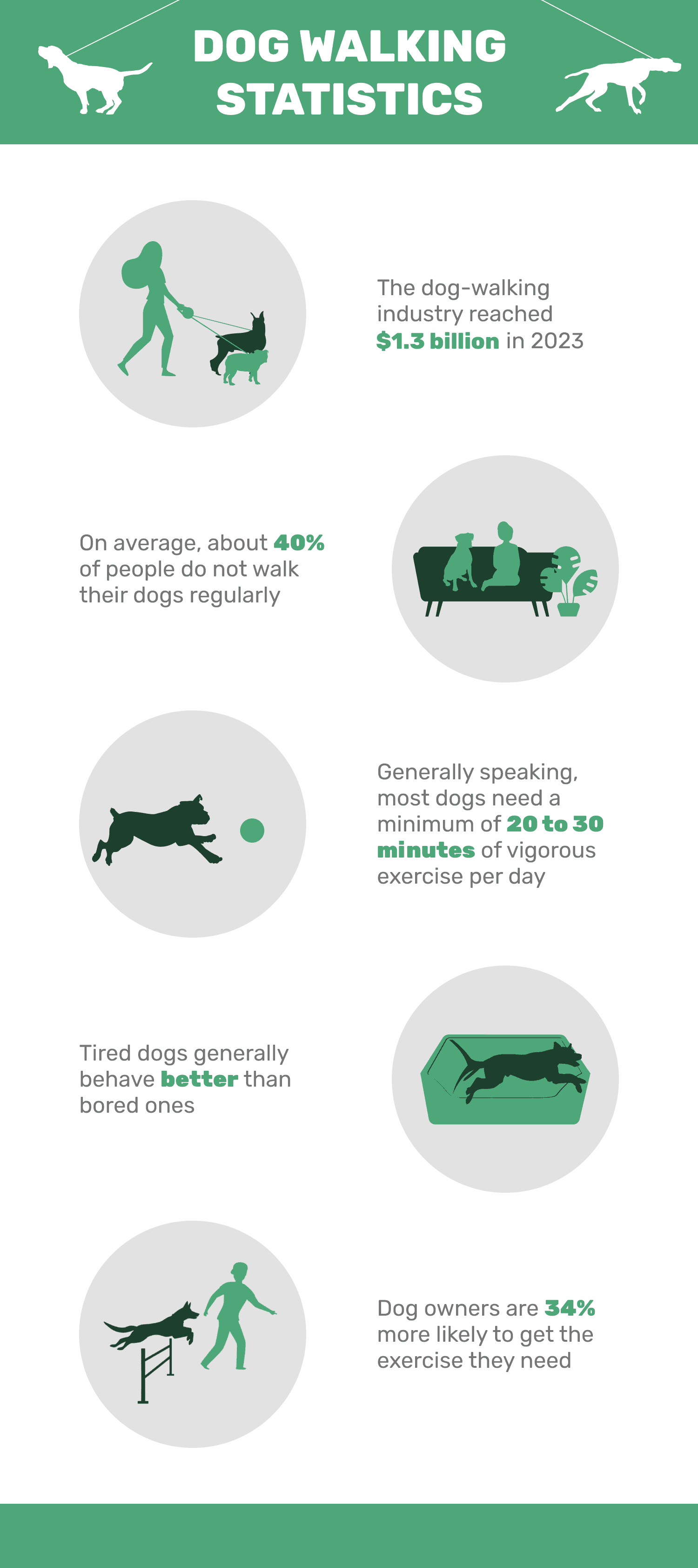Note: This article’s statistics come from third-party sources and do not represent the opinions of this website.
One of the first things that people ask before bringing home a new dog is how much activity that specific breed requires. Even with this information, there is still a large chunk of dog owners who don’t give their pets the minimum daily exercise requirement. While life as a human tends to get busy, it doesn’t mean that we can slack on our responsibilities to our pets. If we hope to give them long, healthy lives, then taking them outdoors is crucial to not only their well-being but to ours as well.
Whether you follow a strict schedule and walk your pets twice per day or are a bit more lenient with their exercise routine, we have put together some of the most interesting dog-walking facts for you to read.
The 10 Dog Walking Statistics
- Between 30% and 70% of people walk their dogs regularly.
- On average, about 40% of people do not walk their dogs regularly.
- The US dog walking industry had a market revenue of $1.3 billion in 2023.
- The dog walking industry has grown at a CAGR of 1.2% over the past 5 years.
- Forecasts predict the global pet care market will reach $358.62 billion by 2027.
- Tired dogs generally behave better than bored ones.
- Dog ancestors sometimes traveled over 100 miles per day in search of food.
- Obesity in pets is associated with other medical issues like cardiovascular disease, liver disease, osteoarthritis, and insulin resistance.
- Generally speaking, most dogs need a minimum of 20 to 30 minutes of vigorous exercise per day.
- Dog owners are 34% more likely to get the exercise they need.

The Number of People Who Walk Their Dogs
1. Between 30% and 70% of people walk their dogs regularly.
(Psychology Today)
Psychology Today reports on several studies that took place at several famous universities around the world. The findings of these studies showed that, depending on many factors, the number of people who walk their dogs daily ranges from between 30% and 70%. This also means that these people were putting in more time and effort for their pets.
On average, they walked their dogs nine times per week, lasting around 34 minutes for each walk. That means that people who walk their dogs spend about 11 days out of the year walking them.

2. On average, about 40% of people do not walk their dogs regularly.
(Psychology Today)
Now that we know about how many people walk their dogs, it’s safe to ask how many people don’t walk their dogs. In the same study in the first statistic, it was found that nearly 40% of people do not walk their dogs regularly. Oddly enough, 78% of people said that dogs deserved to be walked twice a day.
Of the participants, many admitted that they skip walks each week out of laziness, stress, or other responsibilities.
The Dog-Walking Industry
3. The US dog walking industry had a market revenue of $1.3 billion in 2023.
(IBIS World)
In 2020, the dog-walking service industry reached almost $980 million in revenue and jumped up to $1.3 in 2023. This tells us that more and more people are relying on individuals or companies to take their dogs for a walk rather than do it themselves.
This is likely due to work commitments, but it’s good to know that our canine friends are still getting walked nonetheless and that this is a fast-growing market.

4. The dog walking industry has grown at a CAGR of 1.2% over the past 5 years.
(IBIS World)
Just from the statistic above alone, it doesn’t look like these types of services are going to disappear anytime soon. Even with the pandemic in 2020, the dog-walking industry continues to grow every year.
Over the past 5 years, the number of cats and dogs has exceeded the U.S. population, meaning that there is even more potential for this growing industry.
- Related Read:How Much Do Dog Walkers Make? Salary Overview
5. Forecasts predict the global pet care market will reach $358.62 billion by 2027.
(PetPedia)
People adore their pets and want to provide for them in whatever ways they can. In general, the pet industry continues to boom and is going to reach over $350 billion by the year 2027. Statistics predict a compounded annual growth rate of about 6%.
How Dog Walking Affects Pet and Human Health
6. Tired dogs generally behave better than bored ones.
(Found Animals)
One of the top reasons that people get rid of their pets is because of behavioral issues. Most dog owners don’t realize that many of the behavioral problems they experience would likely go away if they kept their dogs mentally and physically stimulated. Signs that your dog needs more exercise include excessively chewing, digging, jumping, barking, or disobedience in general.
Bored dogs are going to find something to burn some of their pent-up energy. When you take the initiative and burn their energy daily, then you’ll notice that your dog is a lot calmer throughout the day.
7. Dog ancestors sometimes traveled over 100 miles per day in search of food.
(Found Animals)
Did you know that all dogs in the world are descendants of wolves? No matter how small your toy breed is, all dogs have a wolf’s natural instincts and DNA telling them to forage for food. Wolves are nomadic animals, and some cover over 100 miles of land in a single day.
While a lot of this drive has been bred out over the years, many of the most popular breeds still have a lot of energy that must get burned.

8. Obesity in pets is associated with other medical issues like cardiovascular disease, liver disease, osteoarthritis, and insulin resistance.
(Better Health)
Nearly 53% of dogs here in the United States are considered overweight. Walking our dogs is crucial if we want them to live as long as possible. In fact, the more overweight a dog is, the more likely they are to develop serious health issues.
These problems often make you spend more money on them due to vet trips and could take your best friend away from you sooner than you’d hoped for.
9. Most dogs need a minimum of 20 to 30 minutes of vigorous exercise per day.
(Pet MD)
You probably already had an idea that dogs needed to be walked for a minimum of 20 minutes each day. Of course, this is the bare minimum and could change depending on the breed you have. Daily exercise requirements take the breed, age, and other factors into account.
It is crucial to carve out time in your schedule to meet these needs or hire a service that can do it for you.

10. Dog owners are 34% more likely to get the exercise they need.
(UVA Health)
Dogs are not the only ones who benefit from daily walks. Humans are also over 34% more likely to meet their weekly minimum exercise requirements when they walk their dogs. These people also tend to be more athletic and energetic compared to people who don’t.
Frequently Asked Questions
Can you walk dogs with health problems and medical concerns?
Often, a light walk throughout the day is beneficial for dogs with health problems. However, you should always talk to your veterinarian directly to discuss your dog’s personal exercise goals or if you plan on making any changes to their regular routine.
To talk to a vet online now, click on the image or button below:
Can I exercise my dog in other ways instead of walking them?
You don’t necessarily have to walk your dog if you would prefer to exercise them in other ways. Running, playing fetch, swimming, herding, and other forms of play are all excellent ways to burn off your pup’s energy.
How much do dog-walking services cost?
The answer to this question depends on a few different factors. Where you live and who you hire are two that could drastically affect how much it costs to pay someone to walk your dog. You should expect to pay about $15 to $20 for every 20-minute walk.
Conclusion
It is understandable to have days where you just don’t feel up for a walk, but that doesn’t mean that you can’t still give your dog the exercise they need and deserve. Even if you have a few rounds of tug-o-war, keeping our dogs active is crucial for not only their health but ours as well. Part of the responsibility of having a pet is keeping their minds and bodies stimulated and healthy.
Even though there is a good chunk of people who already walk their dogs regularly, those numbers aren’t close to perfect, and we should continue to strive for excellence when it comes to our forever friends.
See Also:
Featured Image Credit: Ljupco Smokovski, Shutterstock
Contents
- The 10 Dog Walking Statistics
- The Number of People Who Walk Their Dogs
- 1. Between 30% and 70% of people walk their dogs regularly.
- 2. On average, about 40% of people do not walk their dogs regularly.
- The Dog-Walking Industry
- 3. The US dog walking industry had a market revenue of $1.3 billion in 2023.
- 4. The dog walking industry has grown at a CAGR of 1.2% over the past 5 years.
- 5. Forecasts predict the global pet care market will reach $358.62 billion by 2027.
- How Dog Walking Affects Pet and Human Health
- 6. Tired dogs generally behave better than bored ones.
- 7. Dog ancestors sometimes traveled over 100 miles per day in search of food.
- 8. Obesity in pets is associated with other medical issues like cardiovascular disease, liver disease, osteoarthritis, and insulin resistance.
- 9. Most dogs need a minimum of 20 to 30 minutes of vigorous exercise per day.
- 10. Dog owners are 34% more likely to get the exercise they need.
- Frequently Asked Questions
- Can you walk dogs with health problems and medical concerns?
- Can I exercise my dog in other ways instead of walking them?
- How much do dog-walking services cost?
- Conclusion













